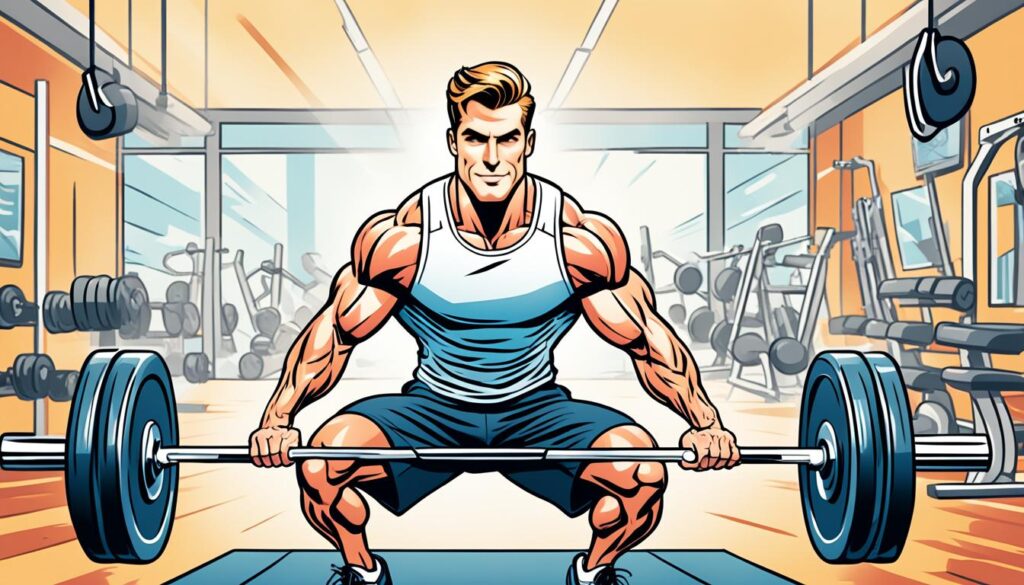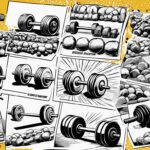Advanced Techniques: types of weights
Did you know that incorporating different types of weights into your fitness routine can significantly enhance your strength training results?
When it comes to weight training, it’s not just about lifting heavy dumbbells. There are various types of weights available that can offer unique benefits and help you achieve your desired fitness goals.
In this article, I will introduce you to different types of weights and their advantages. Whether you’re a beginner or an experienced gym-goer, understanding these options can empower you to design a workout plan that suits your needs and takes your fitness journey to the next level.
Key Takeaways:
- Exploring different types of weights can enhance your strength training results.
- There are various options to choose from, from lightweight resistance bands to heavy barbells.
- Understanding the benefits and unique features of each type allows you to tailor your workout plan.
- Incorporating a variety of weights helps to target different muscle groups and promote overall fitness.
- Experimenting with advanced techniques can challenge your muscles and increase strength and stability.
Types of Weights for Beginners
If you’re new to strength training, it’s important to start with the right types of weights that suit your fitness level. Incorporating the appropriate weights into your workout plan can help you build strength safely and effectively. In this section, I will introduce you to some lightweight options that are perfect for beginners.
Resistance Bands:
One of the most versatile tools for beginners is resistance bands. These elastic bands provide varying levels of resistance, allowing you to gradually increase the intensity of your workouts. They can be used for both upper and lower body exercises, making them ideal for full-body workouts.
Dumbbells:
Dumbbells are another excellent choice for beginners. They come in different weights, allowing you to start with lighter ones and progress as you get stronger. Dumbbells are great for targeting specific muscle groups, and their compact size makes them convenient for home workouts.
Kettlebells:
While kettlebells are slightly more advanced, they can still be suitable for beginners when used with proper form and guidance. Kettlebell exercises engage multiple muscle groups, improving strength, endurance, and cardiovascular fitness. Start with lighter kettlebells to focus on mastering the correct technique before progressing to heavier weights.
Weight Machines:
If you prefer a gym environment, weight machines can be an excellent starting point for beginners. These machines provide stability and guidance throughout the exercises, reducing the risk of injury. They target specific muscle groups and allow for controlled movements, making them safe and effective for beginners.
As a beginner, it’s crucial to focus on proper form and technique rather than lifting heavy weights. Remember to warm up before each workout and listen to your body. Gradually increase the weight and intensity to avoid overexertion and promote steady progress.
To help you get started, here’s a simple beginner’s workout plan that incorporates these types of weights:
- Perform resistance band exercises, such as bicep curls and squats, for 10-12 repetitions and 2-3 sets.
- Use dumbbells for exercises like shoulder press and lunges, aiming for 8-10 repetitions and 2-3 sets.
- Include kettlebell exercises such as kettlebell swings and goblet squats, starting with lighter weights and gradually increasing as you gain strength. Aim for 8-10 repetitions and 2-3 sets.
- Incorporate weight machine exercises like leg presses and chest presses, performing 10-12 repetitions and 2-3 sets.
Remember to rest for 1-2 minutes between sets to allow your muscles to recover. As you progress, you can adjust the weight, reps, and sets to match your increasing strength and endurance.
Advanced Techniques for Weight Training
Ready to take your workout to the next level? Incorporating advanced weight training techniques can challenge your muscles and boost your overall fitness. In this section, I will introduce you to different types of weights and exercises that will help you reach your fitness goals.
1. Barbells
Barbells are a staple in weight training programs for their versatility and effectiveness. They consist of a long steel bar with weights attached to both ends. By using barbells, you can perform compound exercises, such as squats, deadlifts, and bench presses, which engage multiple muscle groups simultaneously. This promotes overall strength and muscle development.
2. Kettlebells
Kettlebells are cast-iron weights with a handle, allowing for dynamic and functional movements. They are ideal for incorporating explosive exercises like swings, snatches, cleans, and Turkish get-ups. Working out with kettlebells improves core strength, stability, and endurance. Additionally, the off-centered weight distribution engages smaller stabilizer muscles, enhancing overall balance and coordination.
3. Weight Machines
Weight machines are commonly found in gyms and provide a controlled and guided range of motion. They come in various designs, targeting specific muscle groups. Machines allow you to isolate and focus on individual muscles, making them beneficial for bodybuilding and rehabilitation purposes. Whether you want to work your chest, legs, back, or arms, weight machines offer a safe and efficient way to strengthen specific areas of your body.
Quote: “Incorporating advanced weight training techniques can challenge your muscles and boost your overall fitness.”
By incorporating barbells, kettlebells, and weight machines into your fitness routine, you can target different muscle groups and improve your strength, stability, and overall performance. Experiment with these advanced techniques and exercises to challenge yourself and take your workout to new heights.
The Role of Weighted Bridges in Leg Workouts
Weighted bridges are a fantastic exercise to strengthen and sculpt your legs. Incorporating weighted bridges into your leg workout routine can help you achieve toned and powerful legs.
What are weighted bridges, you ask? Weighted bridges, also known as hip thrusts, involve lifting your hips off the ground while keeping your feet planted and your back supported. This exercise primarily targets your glutes, hamstrings, and quadriceps, making it a valuable addition to your leg-focused workouts.
There are several variations of weighted bridges that you can try to add variety and challenge to your routine. One popular variation is the single-leg weighted bridge, which involves performing the exercise with one leg extended off the ground. This variation recruits more stabilizing muscles and increases the intensity of the exercise. Another variation is the barbell hip thrust, where you rest a barbell across your hips instead of using dumbbells or other weights.
When incorporating weighted bridges into your leg workout, it’s important to maintain proper form and technique. Start by lying on your back with your knees bent and your feet flat on the ground. Rest the weight (such as a barbell or dumbbell) on your hips, just below your pelvic bones. Engage your glutes and core as you press your hips up towards the ceiling, keeping your shoulders and upper back grounded. Hold for a second and then slowly lower your hips back down.
Weighted bridges can be an effective addition to any leg-focused workout routine. They target multiple muscles in your lower body, helping you build strength, improve stability, and shape your legs. Practice proper form, gradually increase the weight, and experiment with different variations to challenge your muscles and achieve optimal results.

Weighted bridges are an excellent exercise for strengthening and sculpting your legs.
Conclusion
In conclusion, understanding the different types of weights available can significantly enhance your fitness journey. Whether you’re a beginner or looking for advanced techniques, choosing the right weights to incorporate into your workout plan is essential for achieving your fitness goals. Experimenting with different types and techniques allows you to find what works best for you.
For beginners, lightweight options like resistance bands and dumbbells offer a safe and effective way to start building strength. As you progress, incorporating barbells, kettlebells, and weight machines can help challenge your muscles and take your workout to the next level. By targeting specific muscle groups with different exercises, you can improve your overall strength and stability.
One particular exercise that deserves special attention is the weighted bridge. This versatile movement targets the legs and helps tone and strengthen your lower body. Incorporate different variations of the weighted bridge into your leg workout routine to maximize results.
Remember, the key to achieving your fitness goals is to keep pushing yourself, trying new techniques, and listening to your body. With the right combination of weights and exercises, you can create a personalized workout plan that works best for you. So, take the time to explore the world of weights and discover the amazing benefits they can bring to your fitness journey.
FAQ
What are the different types of weights suitable for beginners?
Beginners can start their strength training journey with lightweight options such as resistance bands and dumbbells. These provide a safe and effective way to build strength gradually.
What are some advanced weight training techniques?
To take your workout to the next level, you can incorporate barbells, kettlebells, and weight machines. These tools allow you to challenge your muscles and improve overall fitness through targeted exercises.
How can weighted bridges contribute to leg workouts?
Weighted bridges are exercises that effectively strengthen and sculpt the leg muscles. By incorporating variations of weighted bridges into your routine, you can work towards achieving toned and powerful legs.
What is the role of different types of weights in a workout plan?
Choosing the right types of weights to include in your workout plan is crucial for achieving fitness goals. Whether you are a beginner or looking for advanced techniques, understanding the benefits and unique features of each weight type will help enhance your fitness journey.
How can I determine which type of weight is best suited for me?
It’s important to consider your training goals and preferences when selecting types of weights. Experiment with different options and techniques to find what works best for you and supports your fitness aspirations.
